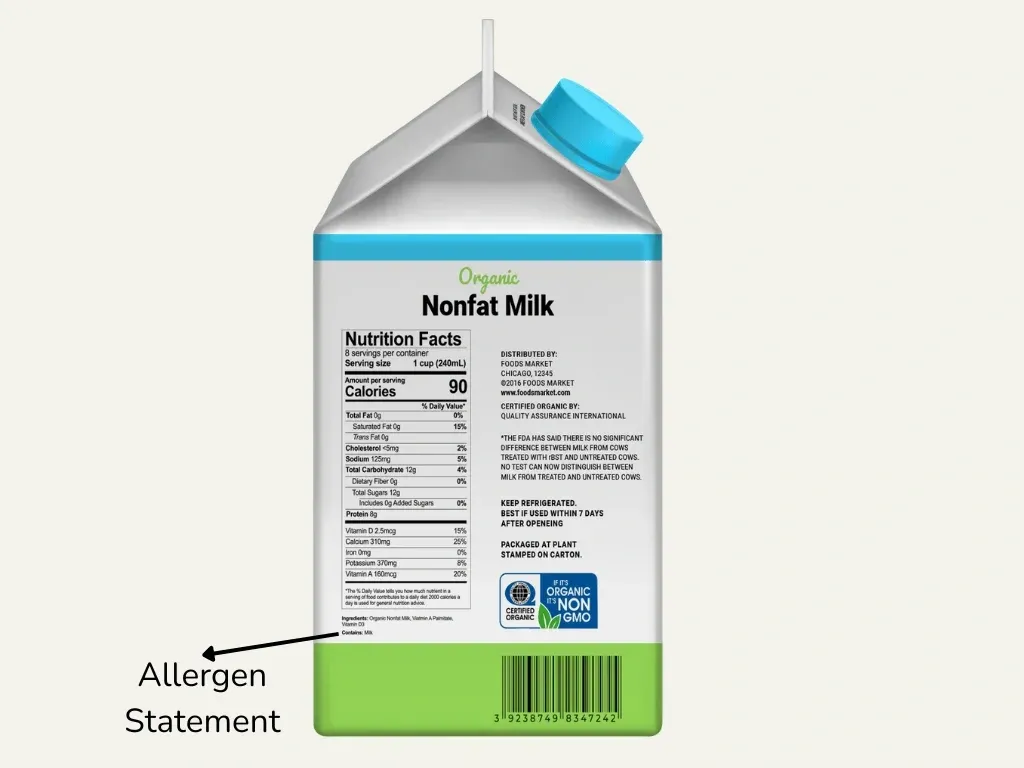Learn how a military member faced sudden anaphylaxis after eating fish. Discover vital 2025 food allergy safety tips for families and first responders.
How To Spot Food Allergens: 2025 Food Safety & Smart Shopping Guide
Discover how to spot hidden allergens in your food with 2025’s latest food safety tips. Stay safe, confident, and allergy-aware with our expert guide.
How to Scan Food for Allergens: 2025 Food Safety Tips & Allergy-Safe Shopping
Scan your food for allergens with smart tech! Stay safe and confident with 2025’s top food safety trends and allergy-aware shopping tips.
How to Spot Hidden Food Allergens: A Life-Saving Label Guide
How to Spot Hidden Food Allergens: A Life-Saving Label Guide Did you know that just eight common food allergens cause 90% of food allergies and serious allergic reactions in the U.S.? These everyday ingredients can trigger reactions within minutes – from mild hives to life-threatening anaphylaxis. Reading labels becomes a vital safety practice if you have food allergies. The FDA requires clear labeling of the “Big 9” major food allergens: milk, eggs, fish, crustacean shellfish, tree nuts, peanuts, wheat, soybeans, and sesame (added recently). Yet concerns remain. Scientists have identified more than 160 foods that can trigger allergic reactions in sensitive people. Many products contain hidden allergens that aren’t obvious on the packaging. The FDA’s data shows that undeclared allergens caused about one-third of reported serious health risks, with milk leading food recalls. The risk extends beyond food labels. Products not regulated by the FDA, such as cosmetics and personal care items, can contain allergens too. This makes watchfulness essential. Apps like Yuka and Food Scan Genius help identify potential allergens faster. This detailed piece shows you how to spot hidden food allergens, understand confusing label terms, and keep yourself and your loved ones safe from dangerous allergic reactions. Why Reading Food Labels Can Save Your Life More than 15 million Americans with food allergies know that reading labels isn’t just helpful—it could save their lives [1]. Your body’s encounter with an allergen can trigger reactions ranging from uncomfortable to deadly within minutes. Why Reading Food Labels Can Save Your Life A quick check of ingredients before eating could mean the difference between safety and rushing to the emergency room. April Clark, a registered dietitian at the Food Allergy Center, emphasizes that “reading and understanding food labels is one of the most important things parents of children with food allergies can do” [1]. How food allergens trigger reactions Your immune system mistakenly flags specific food proteins as harmful during an allergic reaction. Your body creates immunoglobulin E (IgE) antibodies that recognize that specific allergen [2]. Even a tiny amount of that food triggers these antibodies to alert your immune system, which releases histamine and other chemicals into your bloodstream [2]. These chemicals cause allergic reaction symptoms. Your body might react in several ways: Skin reactions: Hives, flushed skin, or rash [3] Digestive issues: Vomiting, diarrhea, and abdominal cramps [3] Respiratory problems: Coughing, wheezing, or difficulty breathing [3] Cardiovascular symptoms: Dizziness, weak pulse, or loss of consciousness [4] Anaphylaxis poses the biggest threat—a severe reaction that can stop breathing and shock your body [4]. Most symptoms show up within two hours of eating, often just minutes after [4]. Scientists haven’t found a cure for food allergies yet [3]. Your best defense lies in avoiding trigger foods completely, which makes reading labels crucial. The rise of hidden allergens in packaged foods Hidden allergens sneak up in unexpected places. Experts warn that these ingredients might “be listed under a different name that you might not be expecting” [5]. To name just one example, “natural flavoring” or “spices” sometimes hide allergens without naming them specifically. Manufacturing practices create extra risks. Food ingredients follow commodity pricing, and manufacturers often use different recipes for the same product [1]. Companies sometimes swap expensive ingredients for cheaper alternatives—which could contain allergens [1]. Changes happen without warning. “Allergens in prepared foods can change over time. Manufacturers may change the ingredients or production methods of their products without notifying consumers,” says Dr. Daines [5]. Experts suggest reading labels every time—even for products you trust. Product sizes bring unexpected dangers. Clark warns parents about checking labels for each size: “‘Fun-sized’ candy and snacks often have different ingredients, which could expose your child to an unexpected allergen” [1]. Cross-contamination adds another layer of risk. Foods without listed allergens might still be dangerous if they’re made in facilities that handle allergenic ingredients [1]. Companies choose whether to include warnings like “may contain” or “processed in a facility that also processes”—these statements remain optional [6]. No rules control these warnings—neither their inclusion nor their wording [7]. Allergens beyond the main nine (milk, eggs, fish, crustacean shellfish, tree nuts, peanuts, wheat, soybeans, and sesame) might lurk unlisted in spices or flavorings [7]. Technology helps tackle these challenges. Apps like Yuka and Food Scan Genius help spot potential allergens in packaged foods quickly. These tools scan barcodes and highlight concerning ingredients, adding extra safety beyond manual checks. People with severe allergies need more than digital tools. Clark recommends asking manufacturers directly about their cross-contamination prevention measures. “If manufacturers have processes in place to prevent cross contamination, they are usually happy to share those processes with you” [1]. Understanding the Big 9 Allergens Image Source: Association for Child Development The FDA has identified specific foods that commonly trigger allergic reactions. More than 160 foods can cause these reactions, but nine foods are responsible for most serious cases in the United States [8]. You need to understand these major allergens if you have food sensitivities or care for someone with allergies. What are the major food allergens identified by the FDA? The FDA now recognizes nine major food allergens: milk, eggs, fish, crustacean shellfish, tree nuts, peanuts, wheat, soybeans, and sesame [9]. These foods cause about 90% of food allergic reactions in America [10]. This “major food allergen” label carries legal weight. Federal regulations require manufacturers to clearly label these ingredients on food packaging [3]. Labels must show the allergen in parentheses after the ingredient name (like “lecithin (soy)”) or list it in a separate “Contains” statement right after the ingredients [3]. Apps like Yuka or Food Scan Genius help people spot these major allergens while shopping. These digital tools scan product barcodes and alert you about allergens, adding an extra safety layer beyond reading labels manually. Differences between Big 8 and Big 9 allergens The official list had only eight major allergens from 2004 to 2021, known as the “Big 8” [11]. The Food Allergen Labeling and Consumer Protection Act of 2004 (FALCPA) first required manufacturers
From Peanuts to Prawns: 8 foods known for triggering allergies – DNA India
Discover the top 8 foods most likely to trigger allergies, from peanuts to prawns. Learn how to stay safe and informed about food allergies in 2025.
Scan Food for Allergens Quickly & Safely
Learn how to scan food for allergens effectively with reliable tools and apps that help identify potentially dangerous ingredients. Stay safe while dining out or grocery shopping
Common Culprits: The most prevalent food allergens are often referred to as the “Big 8”
Common Culprits: The most prevalent food allergens Food allergies affect millions of individuals worldwide, casting a shadow of caution over seemingly innocent meals. The “Big 8” food allergens have earned their notorious reputation, being responsible for the majority of allergic reactions. In this blog post, we’ll take a closer look at these common culprits, shedding light on what makes them prevalent and the challenges they pose for those with allergies. 1. Milk: The Fundamental Allergen Milk, a staple in many diets, is a leading cause of allergic reactions. The culprit is often a protein called casein. For those affected, even small traces of milk can trigger symptoms ranging from hives to more severe reactions like anaphylaxis. 2. Eggs: Beyond Breakfast Eggs, a breakfast favorite, contain proteins that can provoke allergic responses. While egg allergies are more common in children, some individuals carry this sensitivity into adulthood. The challenge lies not only in avoiding eggs themselves but also in navigating various baked goods and processed foods where eggs are prevalent. 3. Peanuts: A Tiny Nut with Big Impact Despite their name, peanuts are legumes, not true nuts. The proteins in peanuts are potent allergens, often causing severe reactions. Peanut allergies are notorious for their persistence into adulthood and the need for strict avoidance due to the potential for life-threatening reactions. 4. Tree Nuts: A Diverse Challenge Tree nuts, including almonds, walnuts, and cashews, pose a diverse challenge for those with allergies. The proteins in tree nuts can vary widely, making it essential for individuals to identify specific nuts triggering their allergic reactions. 5. Soy: A Hidden Component Soy allergies often go beyond avoiding soybeans alone. Soy is a versatile ingredient found in various forms, including soy protein and soy lecithin, making it a challenging allergen to avoid completely. Individuals with soy allergies need to scrutinize ingredient lists diligently. 6. Wheat: More Than Just Gluten Wheat allergies extend beyond gluten sensitivity. While celiac disease involves an immune response to gluten, wheat allergies can trigger reactions to proteins like albumin and globulin. Navigating the world of gluten-free options becomes crucial for those with wheat allergies. 7. Fish: The Oceanic Allergen Fish allergies can be particularly troublesome, as they encompass a wide variety of species. Individuals with fish allergies need to be vigilant about avoiding specific types of fish, and cross-contamination is a constant concern, especially in restaurants. 8. Shellfish: From Crustaceans to Mollusks Shellfish allergies encompass both crustaceans (shrimp, crab, lobster) and mollusks (clams, mussels, oysters). The diverse nature of shellfish makes it imperative for individuals with these allergies to be aware of the specific type triggering their reactions. Conclusion Understanding the Big 8 food allergens is not just a matter of awareness but a crucial aspect of daily life for millions. For those affected, diligent label reading, open communication with restaurant staff, and continuous education about emerging allergens are vital. As the culinary world evolves, so too must our understanding of these common allergens, ensuring that everyone can savor the joy of food without fear. Food Scan Genius: For Consumers with Food Allergies Fortunately, modern technology is offering a helping hand to those navigating the challenges of food allergies. Tools like Food Scan Genius: empower consumers to make informed choices. By scanning product barcodes, Food Scan Genius: provides instant allergen information, allowing individuals to shop with confidence. This innovative solution is a game-changer, providing a sense of control and security in a world where food labels can be intricate puzzles. Check out Food Scan Genius at https://www.scangeni.us
Navigating Shellfish Allergies while Shopping: A Comprehensive Guide
For individuals with shellfish allergies, the simple act of choosing what to eat can be a potential minefield. The consequences of accidental consumption of shellfish can range from mild discomfort to severe, life-threatening reactions. In this blog post, we’ll explore the impact of unintentional shellfish consumption, common symptoms of shellfish allergies, and most importantly, how the Food Scan Genius App (www.scangeni.us) can empower individuals to make informed choices while shopping for food. The Hidden Hazards of Shellfish Allergies: Shellfish allergies are prevalent, affecting both adults and children. Even a small amount of shellfish or shellfish-derived ingredients can trigger an allergic reaction in susceptible individuals. The challenge lies not only in avoiding obvious sources of shellfish but also in identifying hidden shellfish components in various dishes and processed foods. Shellfish allergy is an immune response to proteins found in certain marine animals, such as crustaceans and mollusks. Symptoms of shellfish allergy include hives, itching, swelling of the lips, face, tongue, and throat, difficulty breathing, wheezing, abdominal pain, diarrhea, vomiting, tingling mouth, and anaphylaxis1. If you suspect that you have a shellfish allergy, it is important to seek medical attention immediately1. Diagnosis is done by allergy testing, which includes a physical examination, skin prick test, and blood test2. The only sure way to prevent an allergic reaction to shellfish is to avoid shellfish. If you have a severe allergic reaction to shellfish, you’ll likely need an emergency injection of epinephrine (adrenaline)23. If you’re at risk of anaphylaxis to shellfish, your health care provider can give you a prescription in advance and explain how and when to give the injection2. Common Symptoms of Shellfish Allergies: Digestive Distress: Abdominal pain, bloating, and diarrhea are common digestive symptoms. Nausea and vomiting may also occur. Skin Reactions: Hives, eczema, or general itching can manifest on the skin. Swelling, particularly around the face, lips, and tongue, may occur. Respiratory Issues: Wheezing, coughing, or shortness of breath may be experienced. Severe cases can lead to anaphylaxis, a life-threatening reaction that requires immediate medical attention. Cardiovascular Symptoms: A drop in blood pressure, leading to dizziness or fainting. Rapid or irregular heartbeat. The Mental Toll:Living with a shellfish allergy extends beyond the physical symptoms. The constant fear of accidental shellfish exposure can take a toll on mental health. Social situations involving food become potential stressors, and anxiety levels may rise, affecting overall well-being. Dealing with Accidental Shellfish Exposure: Administer Epinephrine: Individuals with known shellfish allergies should carry an epinephrine auto-injector at all times. Administer the epinephrine shot immediately upon suspecting an allergic reaction. Seek Emergency Medical Attention: Even if symptoms improve after using the epinephrine, seek immediate medical help. Allergic reactions can have a delayed onset or return after the initial treatment. Inform Others: If in a social setting, inform those around you about the situation and the need for urgent medical attention. Ensure someone stays with you until medical professionals arrive. Food Scan Genius App: Empowering Choices: Technology has become a vital ally for individuals managing food allergies. The Food Scan Genius App, available at www.scangeni.us, is a powerful tool designed to empower those with shellfish allergies in their daily lives. Barcode Scanning: The app allows users to scan the barcodes of food products, providing instant information about potential shellfish or shellfish-derived ingredients. This feature helps users make informed choices while shopping for groceries, minimizing the risk of accidental exposure. Product Database: The app maintains an extensive database of food products, continually updated to reflect the latest ingredient information. Users can search for specific products or browse categories to find suitable, shellfish-free options. Allergen Alerts: Food Scan Genius sends alerts to users if a scanned product contains shellfish or shellfish-related ingredients. This real-time information ensures that users are aware of potential risks before making a purchase. User-Friendly Interface: The app is designed with a user-friendly interface, making it accessible to individuals of all ages. Features like personalized profiles and shopping lists enhance the overall user experience. Conclusion: Living with a shellfish allergy requires constant awareness, but with the right tools, individuals can regain control over their dietary choices. The Food Scan Genius App is not just a technological innovation; it’s a lifeline for those navigating the complex world of food ingredients. By leveraging technology, individuals with shellfish allergies can confidently shop for groceries, knowing they have the means to make informed decisions about the foods they consume. Download the Food Scan Genius app at https://app.scangeni.us and take the first step toward a safer and more enjoyable life with a shellfish allergy. Empower yourself, stay informed, and let technology be your ally on the journey to managing shellfish allergies effectively. Check out Food Scan Genius at https://www.scangeni.us and download our app at https://app.scangeni.us











